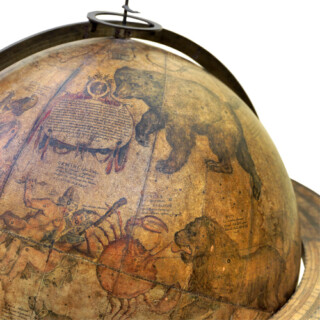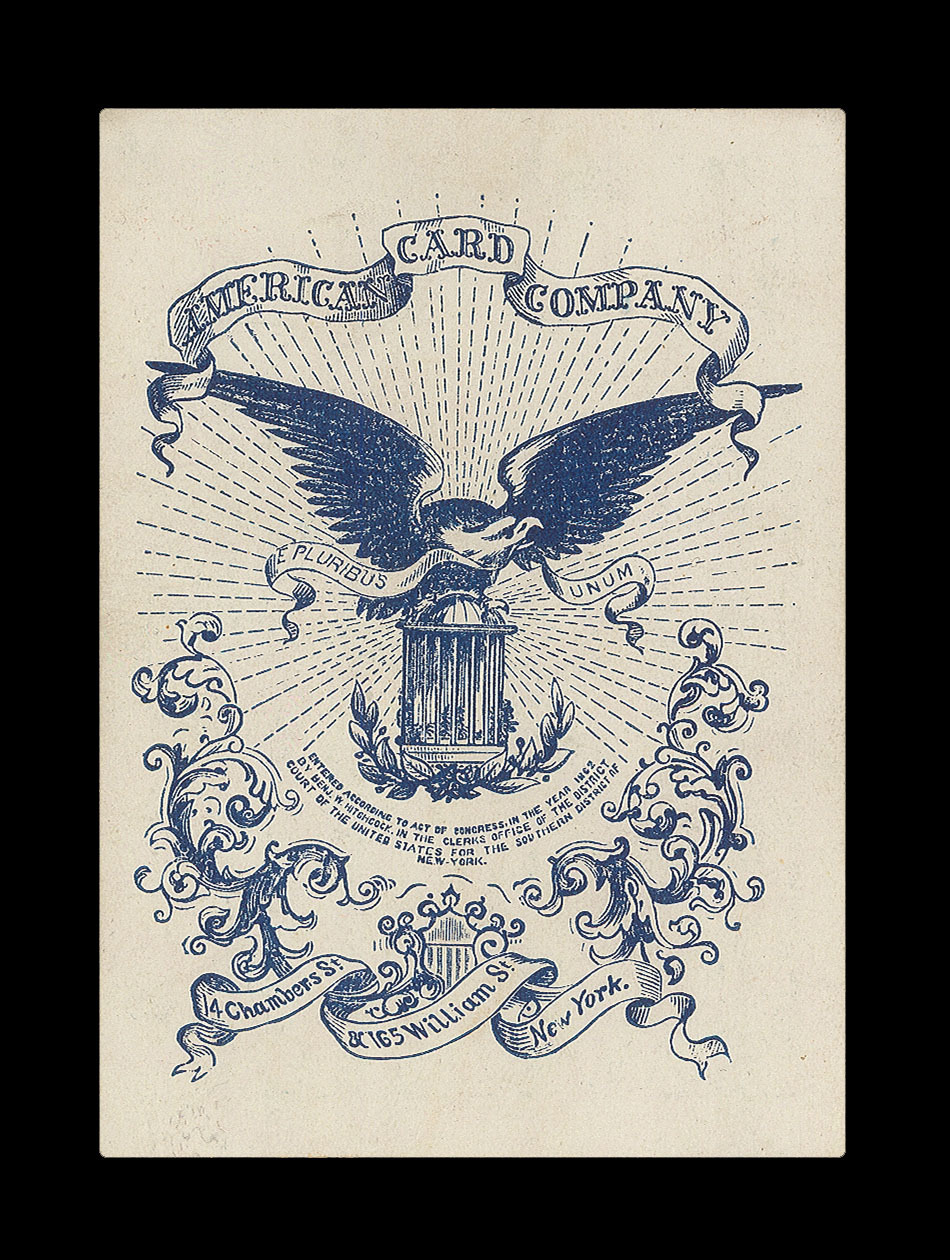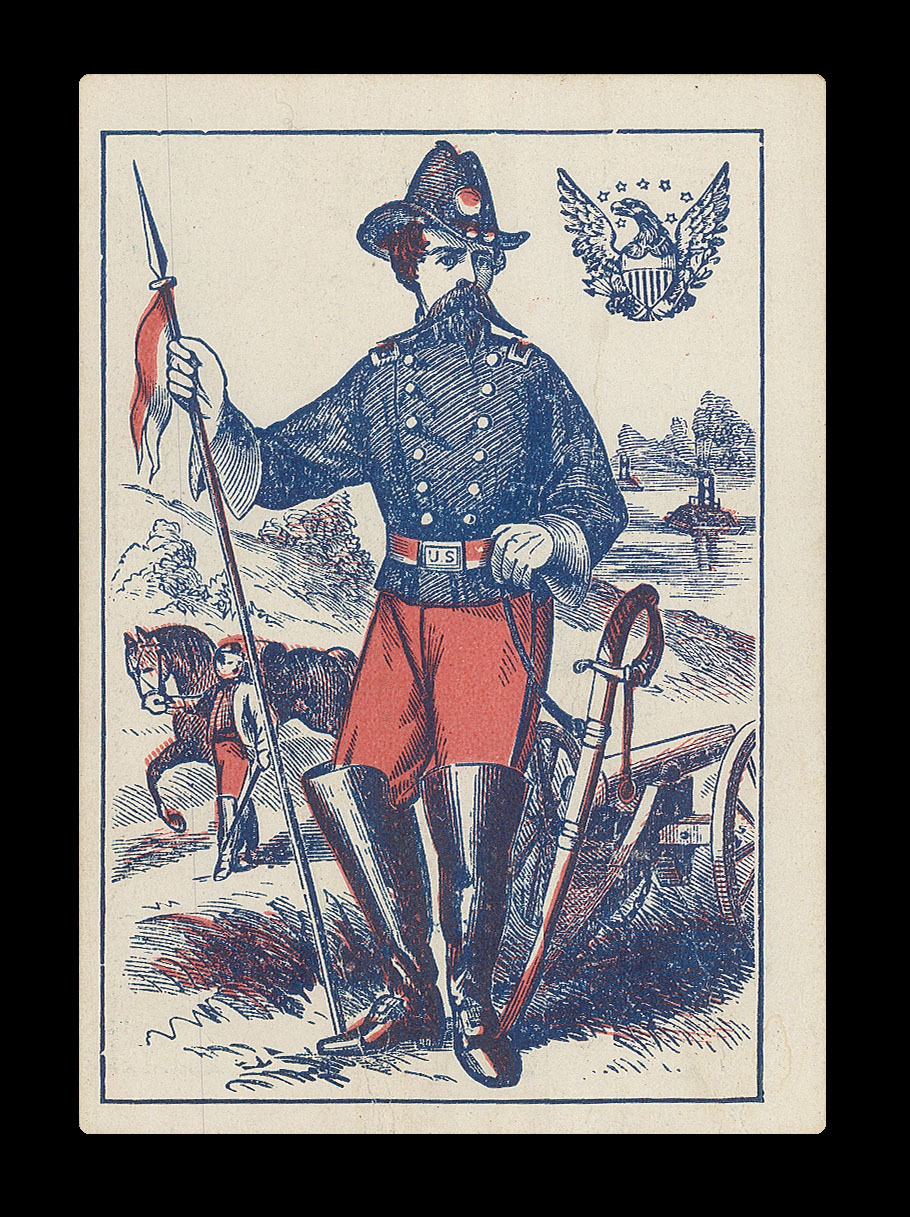National Emblems
American Card Company
[New York,
American Card Company, 14 Chambers St. & 165 William St.,
1862].
52 chromolithograph playing cards, housed in original slipcase lacking upper half, with publisher's sticker and stamp to lower half.
90 by 65mm (3.5 by 2.5 inches).
20696
To scale:
notes:
notes:
The Maker
In 1862, Benjamin W. Hitchcock registered a new deck of cards made by his American Card Company with the New York Clerk's Office. Hitchcock owned a publishing firm at 14 Chambers St., New York, producing sheet music, books, musical instruments, printing presses, and type. It appears that the 'American Card Company', however, may have been established purely to produce this deck of cards during the Civil War, of which Hitchcock also seems have considered...
In 1862, Benjamin W. Hitchcock registered a new deck of cards made by his American Card Company with the New York Clerk's Office. Hitchcock owned a publishing firm at 14 Chambers St., New York, producing sheet music, books, musical instruments, printing presses, and type. It appears that the 'American Card Company', however, may have been established purely to produce this deck of cards during the Civil War, of which Hitchcock also seems have considered...
The Maker
In 1862, Benjamin W. Hitchcock registered a new deck of cards made by his American Card Company with the New York Clerk's Office. Hitchcock owned a publishing firm at 14 Chambers St., New York, producing sheet music, books, musical instruments, printing presses, and type. It appears that the 'American Card Company', however, may have been established purely to produce this deck of cards during the Civil War, of which Hitchcock also seems have considered himself an expert, publishing his own book four years later: 'Hitchcock's chronological record of the American civil war'.
This deck seems to have been distributed in North East America exclusively by the Bufford lithography house in 1863. John Henry Bufford was a lithographer based in Boston, Massachusetts from 1829 to 1870. His output was varied, producing sheet music, views, illustrations and portraits. Bufford's sons took over the firm after his death, expanding the enterprises to the nearby major cities of New York and Chicago. The stamp on the slipcase here identifies the printers as "Bufford's Print Publishing House"; although the firm does not ever seem to have had this as its official name, other publications from the 1860s also bear this imprint.
The Cards
Designed for Union Army soldiers and their families, Hitchcock was "confident that the introduction of National Emblems in the place of Foreign, in Playing Cards, will be hailed with delight by the American People, take pleasure in presenting the Union Playing Cards as the first and only Genuine American Cards ever produced, in the fullest confidence that the time is not far distant when they will be the leading card in the American market".
The traditional French suits have been replaced with Eagles, Shields, Stars and Flags, and the court cards now show identical Colonels, Goddesses of Liberty, and Majors in the place of Kings, Queens and Jacks. The Ace of Eagles is the only pip card with an illustration, depicting an eagle perched, wings spread, atop an empty cage, bearing in its mouth a banner reading "e pluribus unum", the traditional motto and animal of the United States.
In 1862, Benjamin W. Hitchcock registered a new deck of cards made by his American Card Company with the New York Clerk's Office. Hitchcock owned a publishing firm at 14 Chambers St., New York, producing sheet music, books, musical instruments, printing presses, and type. It appears that the 'American Card Company', however, may have been established purely to produce this deck of cards during the Civil War, of which Hitchcock also seems have considered himself an expert, publishing his own book four years later: 'Hitchcock's chronological record of the American civil war'.
This deck seems to have been distributed in North East America exclusively by the Bufford lithography house in 1863. John Henry Bufford was a lithographer based in Boston, Massachusetts from 1829 to 1870. His output was varied, producing sheet music, views, illustrations and portraits. Bufford's sons took over the firm after his death, expanding the enterprises to the nearby major cities of New York and Chicago. The stamp on the slipcase here identifies the printers as "Bufford's Print Publishing House"; although the firm does not ever seem to have had this as its official name, other publications from the 1860s also bear this imprint.
The Cards
Designed for Union Army soldiers and their families, Hitchcock was "confident that the introduction of National Emblems in the place of Foreign, in Playing Cards, will be hailed with delight by the American People, take pleasure in presenting the Union Playing Cards as the first and only Genuine American Cards ever produced, in the fullest confidence that the time is not far distant when they will be the leading card in the American market".
The traditional French suits have been replaced with Eagles, Shields, Stars and Flags, and the court cards now show identical Colonels, Goddesses of Liberty, and Majors in the place of Kings, Queens and Jacks. The Ace of Eagles is the only pip card with an illustration, depicting an eagle perched, wings spread, atop an empty cage, bearing in its mouth a banner reading "e pluribus unum", the traditional motto and animal of the United States.
bibliography:
bibliography:
provenance:
provenance:











